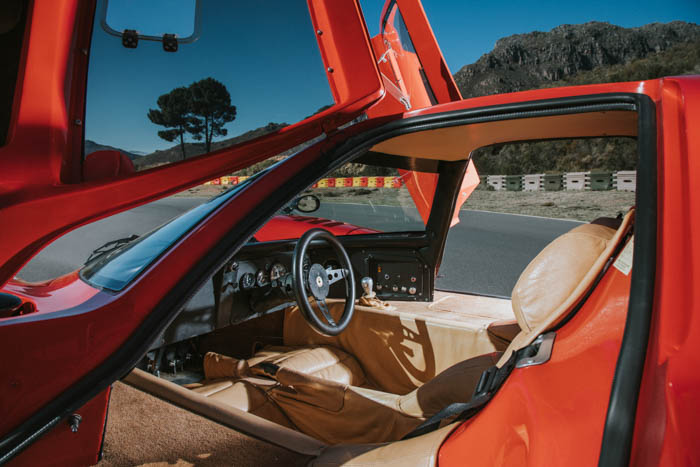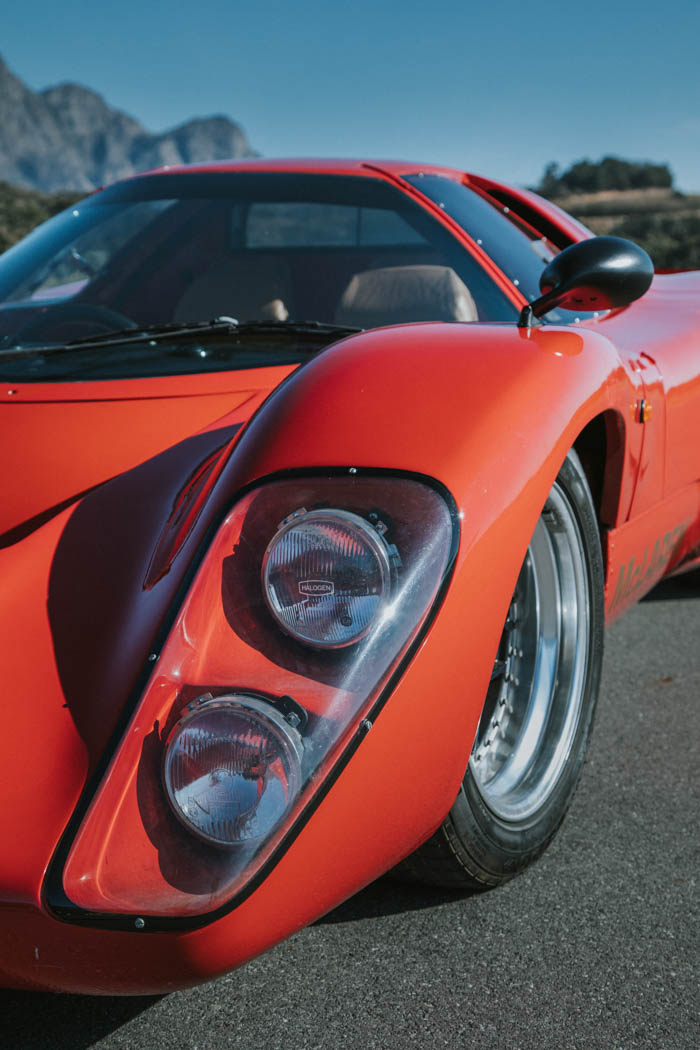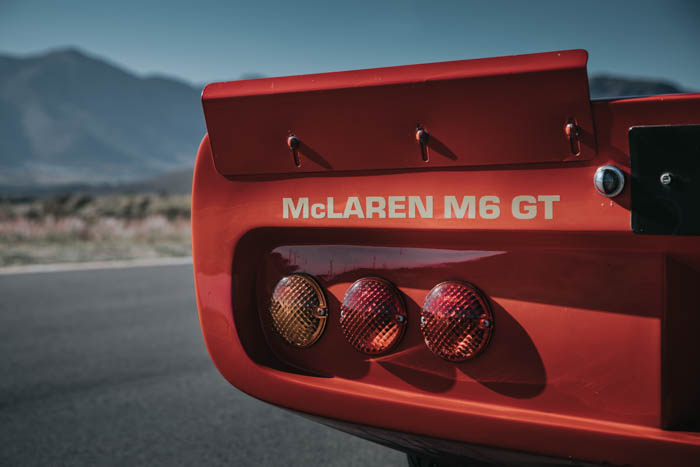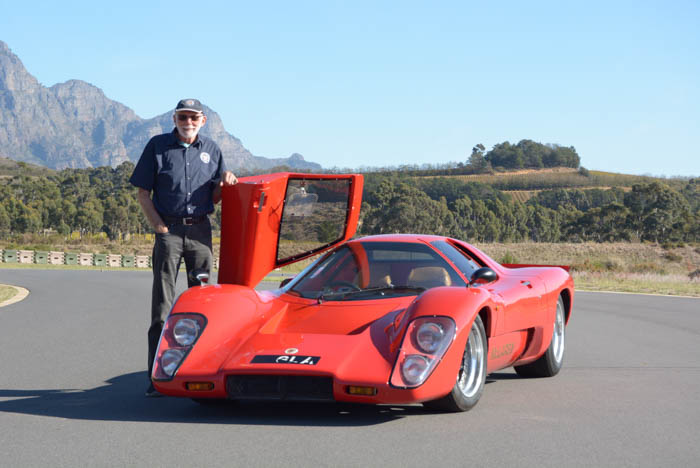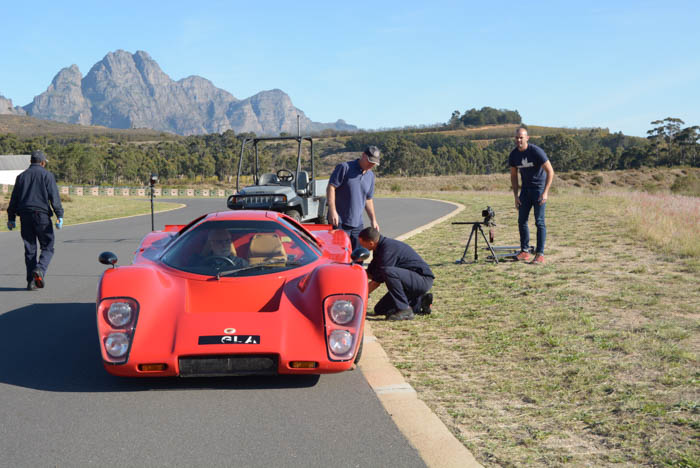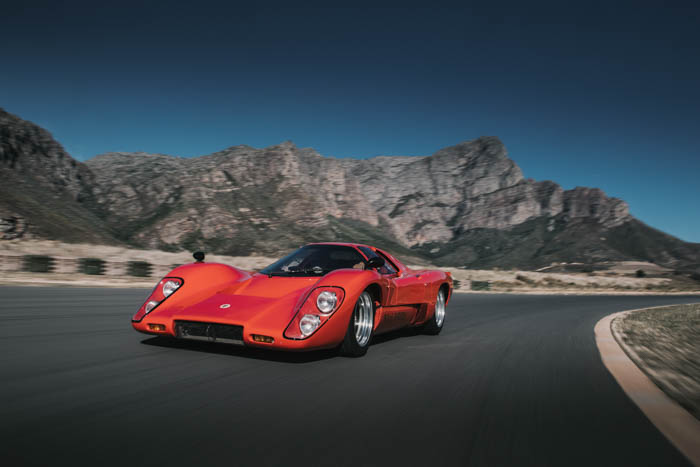
06 Jul Collection in action – McLaren
A dream not seen. Mike Monk at the wheel of Bruce McLaren’s planned Le Mans challenger.
Fifty years ago Bruce McLaren was a successful car constructor and a driver, and after dominating America’s ‘big banger’ CanAm series his thoughts turned to Le Mans. Sadly, the plan was dealt a tragic blow when the talented New Zealander was killed on 2 June 1970 in a testing accident when the rear bodywork of his new M8D CanAm car came adrift at speed along the Lavant Straight at the Goodwood circuit in England. The loss of aerodynamic downforce destabilised the car, which spun, left the track and hit a bunker that was used as a flag station.
At the time, McLaren, aged 32, was in the process of a dream of building a dual purpose-built closed-cockpit car based on the M6 for road use and as a Le Mans competitor. It appears as though the plan was for McLaren to concentrate on building and preparing the works race cars while technical partner Trojan Ltd built the requisite number of additional M6GTs to meet FIA Group 4 homologation requirements. However, protracted rule changes that led to 50 examples having to be built brought the project to a halt – McLaren simply did not have the wherewithal to meet this increased demand.
Styled by Jim Clarke at Specialist Mouldings with input from Bruce and talented F1 designer Gordon Coppuck, the resultant two-door coupé was stunning to look at. The original plan was for a production run of 250 M6BGT customer cars with a choice of powertrains, but once the race car programme was shelved it is unclear just how many cars were in fact built – estimates range from 6 to 9. A couple were said to have been made into road cars, one of which was Bruce’s personal transport, British registration number OBH 500H. Incidentally, one car was bought and campaigned by British driver David Prophet, who had raced in South Africa in the 1963, 1964 and 1965 Rand Grands Prix driving Brabhams.
However, all was not lost. Trojan set about making a run of ‘second generation’ M6GTs based on the M6B platform: records suggest that 28 were produced. Other replicas were made and this car, which is part of the Woods Trust collection housed at FMM, was built on a genuine M6B chassis imported from America in 1989 and is fitted with a 5,7-litre Chevrolet V8 mated with a close-ratio five-speed ZF gearbox. Specialised Mouldings’ original moulds were used to produce the glass fibre body panels. Once verified by Trojan-McLaren Boss Charles Agg, it was given the chassis number M6BGTR50/34. It was classified by Britain’s DVLA licensing authority as a ‘historic vehicle’, and given a 1971 dating and with a period-correct registration number MWV 96J, subsequently re-registered as 2 MLA.
One notable mechanical change was incorporated into the car’s floorpan. The racing-biased set-up of 10-inch wheels up front and 17-inchers at the rear, this car features more practical 16-inch rims all round, which necessitated various modifications to the all-round independent double-wishbone coil-over suspension and disc brakes. This task was carried out by Jimmy Potton, who was once F1 champion Mike Hailwood’s mechanic in the Reg Parnell F1 team.
The car was invited to the highly prestigious Goodwood Festival of Speed in 1996 and took part in the Mulberry Challenge, during which it tackled the hillclimb course, performed a 20-minute high speed trial round the circuit and competed in a timed autotest/wheel change with credible results. Eight years later it returned to Goodwood as a star attraction in the Cartier-sponsored Style et Luxe display.
2 MLA is painted in a rich red with tan leather upholstery and brown carpets. Fully street legal, this wonderful machine even incorporates hatches in its rear wheel arches that will accommodate “reasonably sized soft bags in each side for weekends away etc”. Twice featured in the TAG-McLaren group magazine Racing Line, it also appeared in the Danish Bilen Motor Og Sport publication as part of a three way test with a McLaren F1 and Ferrari F40. It was also used as the camera car for both the McLaren and Benetton F1 teams in the creation of advertisements for Mercedes-Benz cars and Mild 7 cigarettes.
Approaching the M6B GT, I simply felt a massive surge of adrenalin at the prospect of driving this machine. As a teenager, I remember going to a lecture given by Bruce and being awe-struck with the man’s knowledge and friendliness, reinforcing his hero status in my reckoning. A dream then to one day drive a car bearing his name was some 50+ years later becoming a reality…
Lift up the door, remove the steering wheel and step over the wide sill and slide down into the narrow cockpit. Not so fast… the seat is effectively a padded piece of thin foam laid upon the curved aluminium floorpan. shaped as a semi-reclining bucket seat. That is it – absolutely no adjustment whatsoever. What you see is what you get. Sussing out the pedal placement, I am immediately aware that a stout, full-width cross-member mounted just below the base of the windscreen is digging into my shins, restricting movement around the footwell. The driving position is uncompromising to say the least. It is custom built – just not for me.
Clip the steering wheel back into place, get help to adjust and fit the racing harness and it is time to fire up. Ignition and fuel pumps on, hit the button and the monster V8 blasts into life with surprising ease and settles into a menacing rumbles. The clutch is not heavy and first snicks into place without baulking. Raise the revs, release the clutch and this road/race machine pulls away with obvious strength of intent. With so much oomph resonating just behind my head, getting up to speed is just four more snicks away and, stimulated by the booming Chevy motor mounted just behind my head, it goes quickly, fast. Although there is only about 275 kW on offer, the torque is immense, and as the car weighs less than 1 000 kg it really starts to hustle as the red line at 5 800 r/min is approached. Zero-100 km/h takes just around 4,5 seconds and top speed is close to 290 km/h. Not brilliant by modern supercar standards perhaps, but remember this is 45-year-old technology.
The ride is firm but thankfully not too harsh; my shins are soon red and bruised without needing suspension jolts to add to the pain. Fortunately, the brakes are reassuringly powerful without needing Herculean pedal pressure. It is getting hot inside too, so switch on the air-con that was fitted to combat the greenhouse effect engendered by the vast Triplex-supplied windscreen – another feature unique to this car.
Steering is very direct and the car feels planted to the tarmac. In the corners, the McLaren is impressive. Strapped-in tightly, I can feel the g-forces building but aware that I am riding on old, case-hardened tyres, I take great care not to pile on the revs too early on the exits to preclude the risk of spinning off into the barriers. But it is easy to appreciate just how well sorted this car is, based as it is on one of CanAm racing’s most successful chassis.
As a practical road car there is not much going for it. There is an even slimmer passenger seat practically in tandem with the driver’s and storage space is limited to compartments in the rear wheelarches and, er, inside the doors.
So what? Fire it up and enjoy the drive in what is effectively a commuter CanAm…
